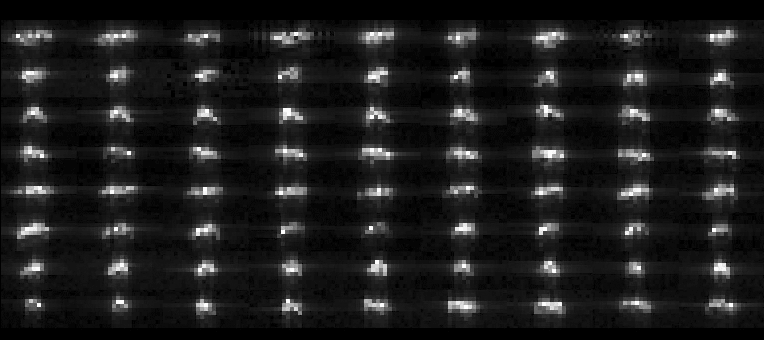Emily Lakdawalla • Feb 19, 2013
Why don't we have any photos of asteroid 2012 DA14 if it came so close?
This seems to be my week for answering questions in the blog. A frequently-asked question last week was: if asteroid 2012 DA14 is coming so close to Earth, why hasn't anyone taken any pictures of it? The people who ask this question seem surprised not to be seeing photos like this one, of asteroid Ida:

Now that 2012 DA14 has whizzed past us, we do finally have some pictures of it, but they still may not satisfy everyone:

There's a movie version, looping the images a total of 9 times:
Why can't we get better pictures? Just like with everything else in space, even the "close"-passing asteroids are smaller than they are close. Here's what we learned about the asteroid from the radar images:
We successfully observed 2012 DA14 at Goldstone on February 16, 18, and 19 and obtained images with resolutions as fine as 3.75 meters x 0.0125 Hz. The images from February 16 show the asteroid completing close to one rotation in about eight hours. Even at this fine resolution the asteroid is so small that we were barely able to resolve it. Inspection of the images shows that the bandwidths and visible extents vary by about a factor of two as the asteroid rotates, hinting that the aspect ratio is close to 2:1. If we assume that the visible extents are about 1/2 of the actual extents, which would be true for a sphere, then the implication is that we were seeing an object with dimensions of roughly 40 meters x 20 meters. Obviously this is very preliminary; we need to look at our data more closely, and ultimately more precise estimates will be require shape modeling.
Ida, which I showed you above, is a large asteroid, about 56 by 21 kilometers across. That is, it's more than a thousand times larger than 2012 DA14. And the photograph wasn't taken from Earth; it was taken by a spacecraft, Galileo, which passed within 2,500 kilometers, and achieved a best resolution of 25 meters per pixel. If Galileo passed exactly as close to 2012 DA14, the little thing would be barely over a pixel in size -- basically not resolved at all. In fact, there's nothing in space that is that small that we have ever seen with a spacecraft. Many of the largest "particles" in Saturn's B ring are the size of 2012 DA14; Cassini will never pass close enough to any of them to be able to resolve them as distinct bodies.
Our "spaceship Earth" passed ten times farther from 2012 DA14 than Galileo did from Ida, at about 27,000 kilometers. So that reduces our ability to see 2012 DA14 by yet another factor of ten. Earth-based telescopes have better resolving power than Galileo, but not by more than a factor of two, thanks to the blurring effects of our atmosphere. And that's even if they can track the fast-moving thing, which only very few can; and the more you zoom in, the harder it is to track. Only a wider view -- and lower resolution -- lets you be sure you can see it passing through your field of view.
To get to the point: there was no hope of getting photographs resolving details on 2012 DA14, no matter how close it got.
The only way to "see" details on close-passing asteroids is with radar. Radar imaging works differently from photography. I posted a long explainer here, but here's the most important facts. The spatial resolving power of a radio telescope is unrelated to the distance from an object; the radio telescope "sees" features on asteroids by broadcasting a radio wave at the asteroid and then timing how long it takes the reflected waves to get back and looking at the Doppler shift of those reflected waves. The sizes of those time delays and Doppler shifts are not dependent upon the distance from the radio telescope. The time delay depends roughly upon the size of the asteroid (it takes slightly longer for the signal to come back from a farther-away bit of the asteroid than from a close bit; if you assume the asteroid is spherical, the difference in time between the first and last arriving echo is half the diameter of the asteroid). And the Doppler shift depends upon how fast the asteroid is spinning (there's more Doppler shift for a faster-spinning asteroid). The only thing that distance affects is the strength of the signal; if something is too far away, the radio telescope isn't able to pick the signal out of background noise.
Radio scientists can improve the signal-to-noise ratio by binning things together, which is what reduces their spatial resolution for faraway objects. But a spatial resolution of 3.75 meters is way, way, way better than any optical instrument can get. Even spacecraft rarely achieve resolutions like that at asteroids, unless (like Hayabusa and NEAR) they actually land. So for any asteroids that we cannot visit with spacecraft -- which is practically all of them -- our best bet to learn about their size and shape is radar imaging. We need more spacecraft to examine these diverse bodies; but we also need to continue to support asteroid observation activities at radio facilities like Goldstone and Arecibo.
Support our core enterprises
Your support powers our mission to explore worlds, find life, and defend Earth. You make all the difference when you make a gift. Give today!
Donate

 Explore Worlds
Explore Worlds Find Life
Find Life Defend Earth
Defend Earth

